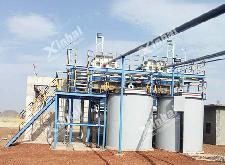

Warm Tip: If you want to know more details about equipment, solutions, etc, please click the button below for free consultation, or leave your requirements!

(Ore samples in mineral processing test)
Mineral processing tests can be roughly divided into small laboratory test, laboratory extended continuous test (also known as continuous test), semi-industrial test and industrial test according to the test scale, depth, breadth, and degree of simulated production.
In this article, we will learn about the above four mineral processing tests!
Small laboratory tests are discontinuous tests conducted with laboratory equipment.
①The laboratory test scale is small, the equipment is generally laboratory type, and the required amount of mineral samples is small. The composition and physicochemical properties of mineral samples in each test are basically the same, and the reproducibility and comparability of test data are good.
②The test operation is carried out in batches, with fewer influencing factors and stable test indicators, which can allow a wide range of exploration over a larger area. Therefore, small laboratory tests are the basis of each test.
The main content of the small laboratory test research stage is to develop a mineral processing method, process structures, and process index suitable for the characteristics of the ore based on the full grasp of mineral resources development information, including geological conditions, development plans, external conditions, and environmental impacts. And the experimental results are used as the main basis for the construction of mineral resources utilization.
For simple and easy-to-sort minerals, the results of small laboratory tests can be used as the basis for feasibility studies or preliminary designs for the construction of mineral processing plants under the condition that the required parameters are met.
The laboratory extended continuous test is a continuous test of the beneficiation process recommended for small laboratory tests in series under laboratory conditions to simulate the production state of the beneficiation process.
The test generally requires the test process to be in continuous operation for 24-72h after adjustment to equilibrium and sampling to commence only after one shift of equilibrium has been reached.
①The test is large, of long duration, with stable test indicators and a high degree of production simulation.
②The test is continuous, resulting in a high degree of confidence in the beneficiation results.
For generally separable minerals, the results of the extended continuous laboratory tests can be used as the basis for a feasibility study or preliminary design for the construction of a mineral beneficiation plant. For complex and difficult-to-separate minerals, whether the test at this stage can be used as a design basis or whether it is necessary to carry out the next test depends on the specific situation.
The semi-industrial test is generally carried out in a specially established semi-industrial pilot plant or workshop, which can be a whole process or partial operation, or a single equipment test.
①The size of the equipment is large, which can better simulate industrial equipment, and the test operation is basically continuous;
②The test process can run for a certain period of time with stability already achieved, with the aim of validating the test process scenario and obtaining techno-economic indicators similar to industrial production.
③Semi-industrial test can identify and determine some factors and parameters that cannot be identified and determined under laboratory conditions, such as equipment models, process parameters, consumption quotas, etc.
When the mineral properties are complex and difficult to be sorted or limited by laboratory conditions, and the continuous testing of the laboratory cannot confirm the characteristics of ore separation and equipment performance, and the optimal technological process and sorting indicators cannot be determined, semi-industrial tests should be carried out.
The semi-industrial test results can generally be used as the basis for the feasibility study and preliminary design of the construction of various mineral processing plants. Therefore, the semi-industrial test content, analysis and testing items and various process parameters must meet the design requirements.
Industrial tests are single machine, partial or full process tests carried out in specially established industrial pilot plants or using a system or even the whole plant of an already producing mineral processing plant.
Since its equipment, process, and technical conditions are basically the same as those in production or future design, the data and various process conditions obtained can better reflect the actual production.
When the scale of the plant is very large, the nature of the ore is complex and difficult to select or the proposed new process, new equipment and intermediate test stage test results still need to be reliably verified under industrial conditions, it is necessary to organise industrial tests.
In a certain sense, the scale of the test reflects the approximate degree of the test to simulate the industrial production, so it can also be used as the basis for dividing the test stage.
The size of the test scale used depends on factors such as mineral grade, mineral composition, and mineral properties. It is recommended that you should choose a professional EPC provider who can offer professional mineral processing test to help you make reasonable process parameters and get the whole processing plant run normally.
If you have any question about mineral processing test, welcome to leave a message or consult online service.
1How Is the Mineral Processing Experiment Important for Beneficiation Plant?
 7
7
 4035
4035
2What Does Mineral Processing Experiment Mainly Include?
 6
6
 3592
3592


What Are the Differences Between CIP and CIL?
 10407
10407
 0
0